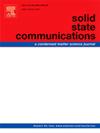揭示了胍(lS) -(+) - 10 -樟脑磺酸盐单晶的非线性光学行为
IF 2.4
4区 物理与天体物理
Q3 PHYSICS, CONDENSED MATTER
引用次数: 0
摘要
胍基单晶由于对强激光具有良好的非线性特性,在光电子领域引起了广泛的关注。它们的氢键网络提供了强烈的非线性响应,这对光子学中使用的晶体是重要的。本文报道了用慢蒸发溶液法合成并生长了胍(lS) -(+) - 10 -樟脑磺酸盐(GCS)单晶。我们的实验分析包括傅里叶变换红外光谱(FTIR)来了解化合物中现有的官能团。在Hirshfeld表面观察到的主要相互作用是O··H和H··H,分别占40.9%和50.5%。此外,GCS晶体具有独特的光学特性,包括3.86 eV的直接带隙和40%的宽光学透明度。此外,GCS在高达320°C的温度下表现出很大的热稳定性,这使得它适合在更高温度下的设备使用。此外,通过计算非线性吸收系数、β和非线性折射率来确定晶体的三阶非线性,n2揭示了晶体作为光学限制器的非线性特性。总之,本研究为氢键胍盐的合成和设计开辟了新的可能性,促进了NLO的应用。本文章由计算机程序翻译,如有差异,请以英文原文为准。
Unraveling the nonlinear optical behaviour of guanidinium (lS) – (+) – 10 – camphorsulfonate single crystal
Guanidine based single crystals have gained attention in the optoelectronic sector due to their excellent nonlinear behaviour towards high intense laser. Their hydrogen-bonded networks provide a strong nonlinear response which is significant for the crystals used in photonics. In this work, we report the synthesis and growth of guanidinium (lS) - (+) - 10 - camphorsulfonate (GCS) single crystals via slow evaporation solution method. Our experimental analysis encompassed Fourier transform infrared (FTIR) spectroscopy to understand the existing functional groups within the compound. The dominant interactions observed in Hirshfeld surface are O···H and H···H, contributing 40.9 % and 50.5 %, respectively. Besides, it is demonstrated that the GCS crystal has unique optical characteristics, including a direct bandgap of 3.86 eV and a wide optical transparency of 40 %. Moreover, GCS exhibits a large thermal stability up to a temperature of 320 °C which makes it suitable for device usage at higher temperatures. Additionally, determining the third-order nonlinearity of the entitled crystal by computing the nonlinear absorption coefficient, β and nonlinear index of refraction, n2 sheds light on the nonlinear characteristics of the crystal owing to its applicability as an optical limiter. Overall, the research opens up new possibilities for the synthesis and design of hydrogen-bonded guanidinium salts for the advancement of NLO applications.
求助全文
通过发布文献求助,成功后即可免费获取论文全文。
去求助
来源期刊

Solid State Communications
物理-物理:凝聚态物理
CiteScore
3.40
自引率
4.80%
发文量
287
审稿时长
51 days
期刊介绍:
Solid State Communications is an international medium for the publication of short communications and original research articles on significant developments in condensed matter science, giving scientists immediate access to important, recently completed work. The journal publishes original experimental and theoretical research on the physical and chemical properties of solids and other condensed systems and also on their preparation. The submission of manuscripts reporting research on the basic physics of materials science and devices, as well as of state-of-the-art microstructures and nanostructures, is encouraged.
A coherent quantitative treatment emphasizing new physics is expected rather than a simple accumulation of experimental data. Consistent with these aims, the short communications should be kept concise and short, usually not longer than six printed pages. The number of figures and tables should also be kept to a minimum. Solid State Communications now also welcomes original research articles without length restrictions.
The Fast-Track section of Solid State Communications is the venue for very rapid publication of short communications on significant developments in condensed matter science. The goal is to offer the broad condensed matter community quick and immediate access to publish recently completed papers in research areas that are rapidly evolving and in which there are developments with great potential impact.
 求助内容:
求助内容: 应助结果提醒方式:
应助结果提醒方式:


